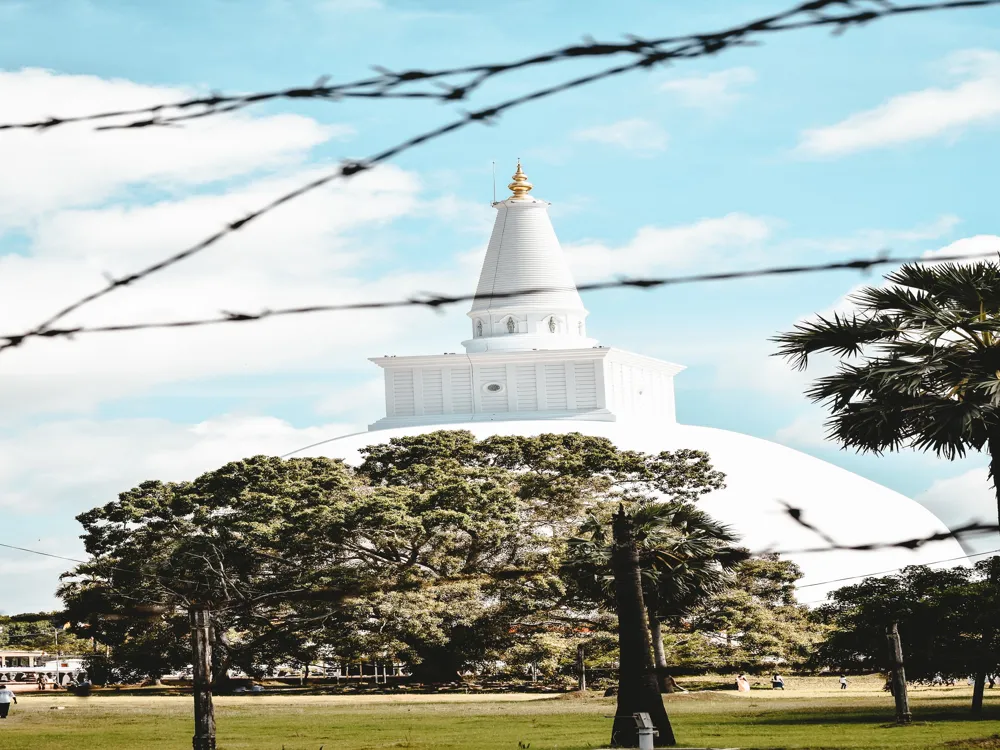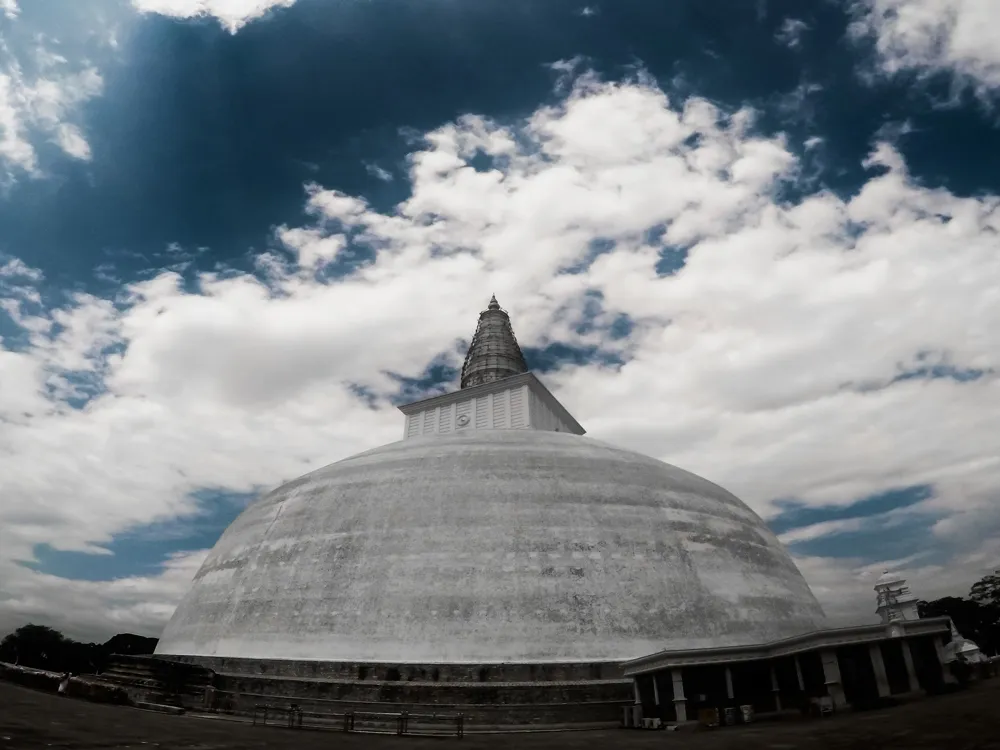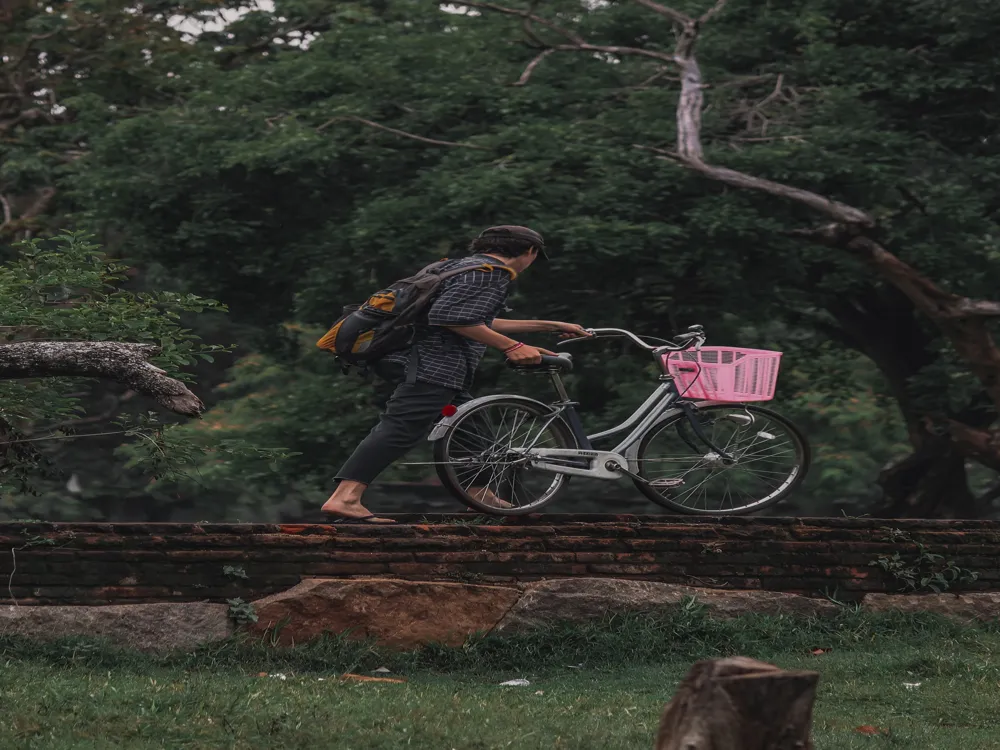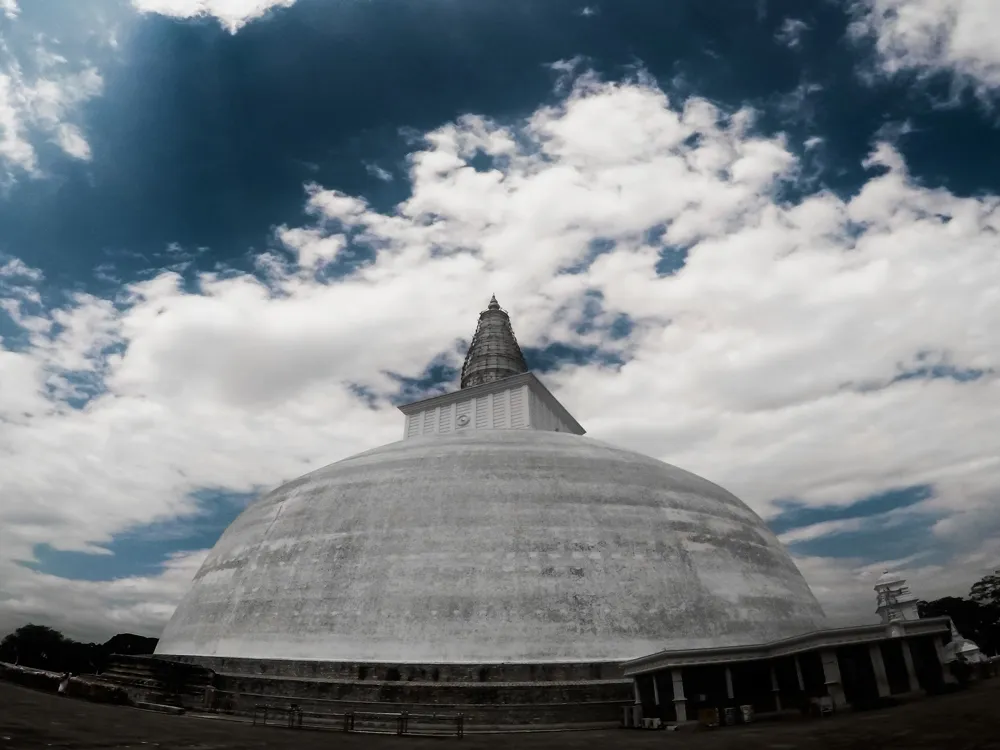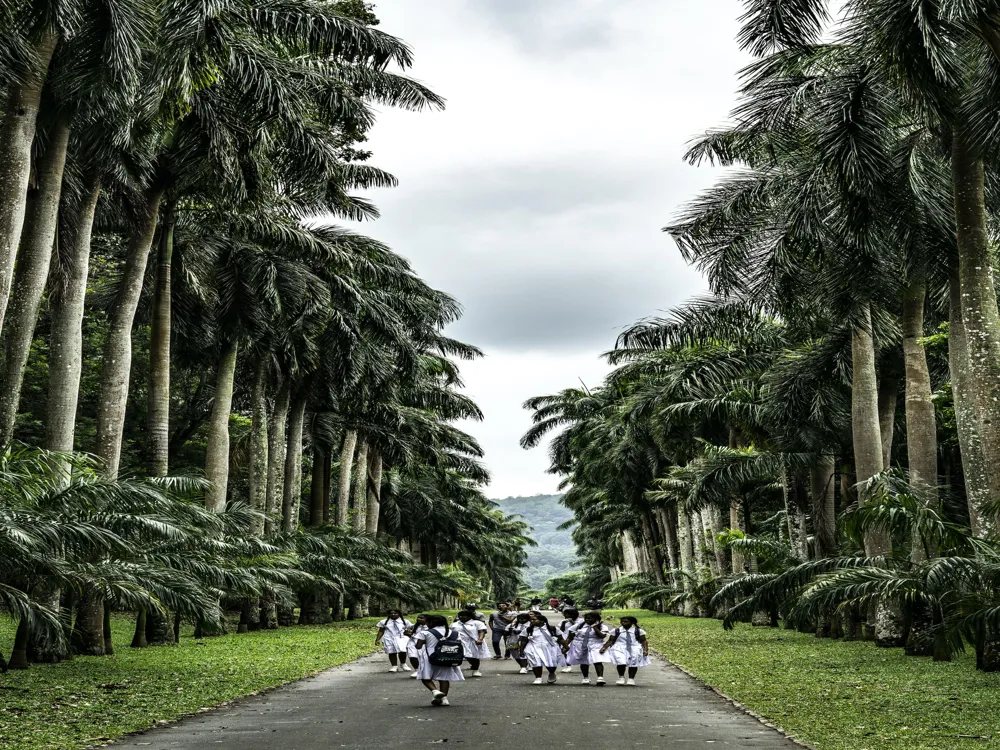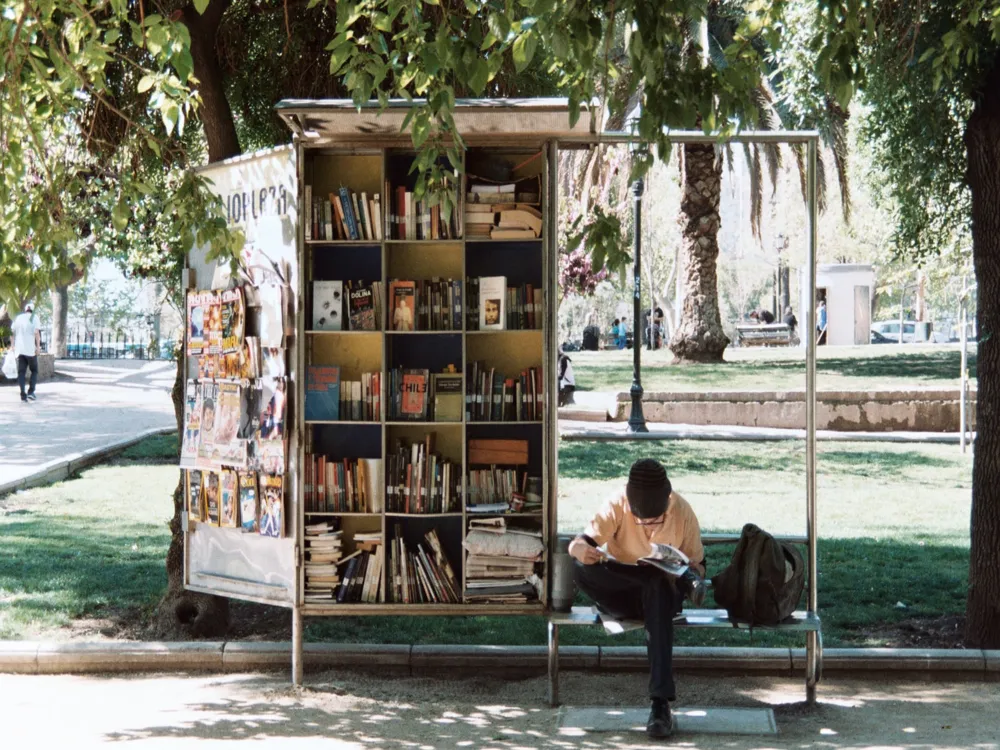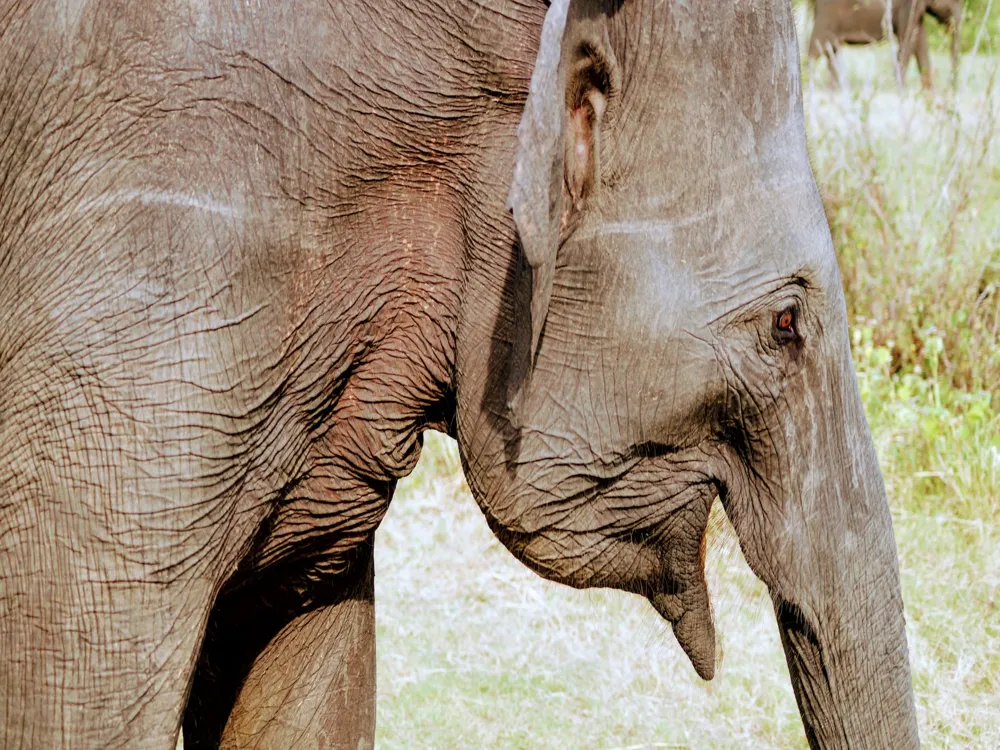The Lankarama Dagoba, located in the ancient city of Anuradhapura in Sri Lanka, is a significant historical and religious landmark. This Buddhist stupa, believed to have been constructed by King Valagamba in the 1st century BC, stands as a testament to the rich cultural heritage of Sri Lanka. The Dagoba is revered for its unique architectural style and historical significance, attracting thousands of pilgrims and tourists annually. Anuradhapura, once a thriving capital of the Sinhalese Kingdom, is known for its well-preserved ruins of an ancient Sri Lankan civilization. The city is considered sacred to the Buddhist world and is a pivotal part of the country's cultural and religious history. Lankarama Dagoba, among the city's many stupas, holds a special place for its historical ties to the reign of King Valagamba, a ruler noted for his efforts to restore and protect Buddhist traditions during times of turmoil. The stupa is an embodiment of the ancient architectural skills of the Sinhalese. Despite its modest size compared to other giant stupas in the city, Lankarama Dagoba is unique in its construction and design. Unlike the traditional bell-shaped stupas, it features a structure that resembles a paddy heap, giving it a distinct identity. The Dagoba has undergone several renovations throughout history, each adding layers to its story and architectural complexity. The architectural design of Lankarama Dagoba is a reflection of the rich cultural and religious history of Sri Lanka. The structure, while modest in size, is significant for its unique design and construction methods. The Dagoba's design deviates from the traditional bell shape, instead resembling a paddy heap, a feature that sets it apart from other stupas in Anuradhapura. The construction techniques used in building the Dagoba are a marvel of ancient engineering. Built from bricks, the stupa has a solid core, a feature typical of ancient Sri Lankan stupas. The bricks are laid in a unique pattern, ensuring stability and longevity. This technique showcases the advanced understanding of materials and construction methodologies of the era. Over the centuries, the Lankarama Dagoba has undergone several restorations, which have contributed to its current appearance. Each restoration, influenced by the prevailing architectural styles of the time, has added a new layer to its historical and architectural narrative. The most recent renovations have aimed to preserve the original essence of the Dagoba while ensuring its structural integrity. Visitors should dress respectfully, covering shoulders and legs, as the Dagoba is a sacred religious site. The ideal time to visit is early morning or late afternoon to avoid the midday heat and to experience the serene atmosphere. Photography is allowed, but it is advised to be respectful and avoid posing inappropriately in front of religious symbols. Lankarama Dagoba is accessible via multiple modes of transportation. The most convenient way to reach the Dagoba is by road, as Anuradhapura is well-connected by bus and taxi services from major cities in Sri Lanka. For a more scenic route, visitors can opt for the train service to Anuradhapura, followed by a short taxi or tuk-tuk ride to the Dagoba. For international tourists, the closest airport is the Bandaranaike International Airport, from where they can take a taxi or a bus to Anuradhapura. Read More:Overview of Lankarama Dagoba in Anuradhapura
Architecture of Lankarama Dagoba
Tips When Visiting Lankarama Dagoba
Dress Appropriately
Best Time to Visit
Photography Etiquette
How To Reach Lankarama Dagoba
Lankarama Dagoba
Anuradhapura
₹ 21,999 onwards
View anuradhapura Packages
Weather :
Tags : Temple
Entry Fee: : NA
Timings: : NA
Planning a Trip? Ask Your Question
Anuradhapura Travel Packages
View All Packages For Anuradhapura
Top Hotel Collections for Anuradhapura

Private Pool

Luxury Hotels

5-Star Hotels

Pet Friendly
Top Hotels Near Anuradhapura
Other Top Ranking Places In Anuradhapura
View All Places To Visit In anuradhapura
Faq on Anuradhapura
What is Lankarama Dagoba in Anuradhapura?
Lankarama Dagoba is a significant Buddhist stupa located in Anuradhapura, Sri Lanka. It is a renowned historical and religious site revered by Buddhists.
When was Lankarama Dagoba built?
Lankarama Dagoba was built during the 1st century BC by King Valagamba, also known as Vattagamani Abhaya, after reclaiming the throne from South Indian invaders.
What is the significance of Lankarama Dagoba?
Lankarama Dagoba holds great religious and historical significance in Sri Lanka. It is believed to enshrine relics of the Buddha and serves as a sacred pilgrimage site for Buddhists.
How tall is Lankarama Dagoba?
The exact height of Lankarama Dagoba may vary due to restoration efforts over the centuries. However, it stands as a prominent structure in the Anuradhapura landscape, showcasing impressive architectural and religious symbolism.
Can visitors enter Lankarama Dagoba?
Currently, visitors are not allowed to enter the interior of Lankarama Dagoba. However, they can circumambulate the stupa and admire its architecture and surroundings.
View anuradhapura Packages
Weather :
Tags : Temple
Entry Fee: : NA
Timings: : NA
Planning a Trip? Ask Your Question
Anuradhapura Travel Packages
View All Packages For Anuradhapura
Top Hotel Collections for Anuradhapura

Private Pool

Luxury Hotels

5-Star Hotels

Pet Friendly
Top Hotels Near Anuradhapura
Other Top Ranking Places In Anuradhapura
Faq on Anuradhapura
What is Lankarama Dagoba in Anuradhapura?
Lankarama Dagoba is a significant Buddhist stupa located in Anuradhapura, Sri Lanka. It is a renowned historical and religious site revered by Buddhists.
When was Lankarama Dagoba built?
Lankarama Dagoba was built during the 1st century BC by King Valagamba, also known as Vattagamani Abhaya, after reclaiming the throne from South Indian invaders.
What is the significance of Lankarama Dagoba?
Lankarama Dagoba holds great religious and historical significance in Sri Lanka. It is believed to enshrine relics of the Buddha and serves as a sacred pilgrimage site for Buddhists.
How tall is Lankarama Dagoba?
The exact height of Lankarama Dagoba may vary due to restoration efforts over the centuries. However, it stands as a prominent structure in the Anuradhapura landscape, showcasing impressive architectural and religious symbolism.
Can visitors enter Lankarama Dagoba?
Currently, visitors are not allowed to enter the interior of Lankarama Dagoba. However, they can circumambulate the stupa and admire its architecture and surroundings.







